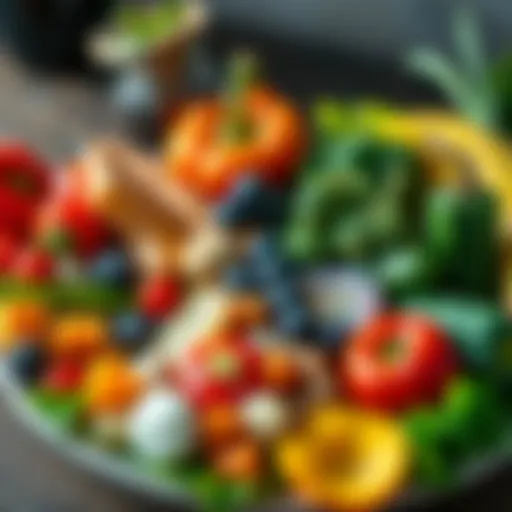The Importance of Hay Racks in Modern Farming
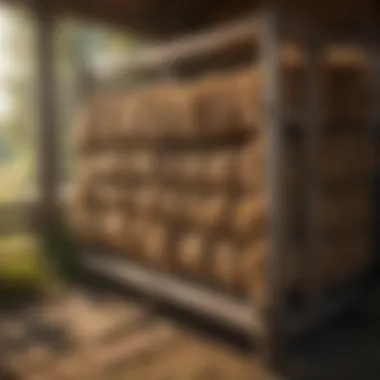

Intro
Hay racks play an understated yet critical role in modern agricultural practices. Often overlooked among the myriad of farming tools and technologies, these structures manifest as essential components in the efficient management of hay storage and livestock care. Their evolution isn't just a reflection of changing agricultural practices but also mirrors the dynamics of livestock management itself. Today, as fears regarding sustainability and efficiency loom large, understanding the significance of hay racks becomes imperative for those in the agriculture space.
In this article, we will explore various facets of hay racks, from historical evolution to their contemporary relevance. We’ll dig into the design variations that suit different farming criteria and conditions, while also touching upon the materials commonly deployed in their construction. This initiative isn't merely about facilitating hay storage; it dives into how the integration of hay racks contributes to sustainable agricultural practices. Additionally, we'll consider the tangible impacts on livestock management this appliance brings forth.
Latest Trends in Agriculture
Agriculture isn't static—it's an ever-evolving field influenced by trends that range from technological advancements to shifts in consumer demand.
Overview of Current Trends
Recent trends indicate an upward trajectory toward precision farming, which emphasizes efficiency and sustainability. Farmers now seek tools that not only help them work smarter but also have a lesser environmental impact. Hay racks, in this context, have made a mark. By allowing for better hay storage, they reduce waste associated with spoiled or poorly stored hay.
Impact of Technology on Farming Practices
Technology shapes today's agricultural landscape, impacting farming methods significantly. Innovations such as automated feeding systems link directly with the hay racks employed, enhancing efficiency. By integrating smart technologies like sensors and data tracking, farmers can regulate hay supplies for livestock, ensuring optimal nutritional intake.
"The fusion of traditional tools with modern technology is the future of farming."
This intersection between age-old practices and contemporary technology creates a bridge that enhances workflow and efficacy in agricultural operations.
Sustainable Practices: Towards a Greener Future
Sustainability has become more than just a buzzword in the agricultural realm; it's now a necessity. Farmers are gradually embracing methods that not only maximize productivity but also ensure the preservation of resources for future generations.
Importance of Sustainability in Agriculture
Through sustainable practices, farmers tackle challenges like soil erosion, water scarcity, and climate change. The role of hay racks emerges as vital since they help in proper hay management, which is linked to minimizing waste. Efficient hay storage reduces the demand for additional resources, which is beneficial for our planet.
Methods for Sustainable Farming
Farmers can adopt various methods to enhance sustainability:
- Crop Rotation: Helps in maintaining soil health.
- Cover Cropping: Reduces soil erosion and enhances soil nutrients.
- Composting: Improves soil structure while recycling organic material.
- Efficient Water Management: Ensures minimal waste during watering.
Hay racks fit neatly into this framework, as they help in storing quality feed for livestock, thereby reducing the waste typically seen from neglected or spoiled hay.
Gardening Techniques and Tips
Though focused on farming, the principles behind effective hay storage can also apply to gardening practices, creating an interconnected understanding.
Essential Gardening Tools and Equipment
Farmers and garden enthusiasts should consider the essential tools that can complement hay racks in managing their operations, including:
- Good quality pruners
- Wheelbarrows for transportation
- Soil testers to check nutrient levels
- Mulching equipment for maintaining soil moisture
Seasonal Gardening Practices
Understanding the seasons is crucial. For instance, align hay rack usage with the right time of year to maximize feed storage and efficacy. Timing is everything in agriculture; using the right practices and tools during the right season leads to successful harvests.
Equipped with the insights gained here, farmers, horticulturists, and agronomy enthusiasts can position themselves favorably in this evolving landscape, embracing the significance of hay racks as integral to modern agricultural practices.
Preface to Hay Racks
Hay racks, at first glance, may not seem like a cornerstone of agricultural practices. Yet, they are quietly pivotal, serving as practical tools that support efficient hay storage and livestock management. This article will illuminate their multifaceted role in farming, emphasizing the critical nature of hay racks in modern agricultural ecosystems.
Definition and Purpose
Hay racks are structured devices used to store hay, ensuring that it stays dry and free from waste. Typically elevated, these racks provide essential airflow around the hay, safeguarding it against mold and rot. By keeping hay off the ground, hay racks also limit exposure to pests and moisture, maintaining the quality of the forage, which in turn is integral for animal health. Farmers find that using hay racks can streamline their operations, drastically reducing the time spent on hay management.
Historical Development
Tracing the roots of hay racks unveils a rich history steeped in necessity. Originally, farmers relied on simple wooden frames or makeshift structures to store hay, often constructed from locally sourced materials. These early designs varied significantly depending on regional climates and farming practices. For instance, in moist areas, farmers built more enclosed racks to protect the hay, while drier regions favored open designs, prioritizing airflow.
As agriculture evolved, so did the design and functionality of hay racks. Over time, innovations have led to modern incarnations that incorporate a blend of practicality and efficiency. Today‘s hay racks often feature durable materials, such as treated wood or metal, which increases their longevity and resistance to the elements. This development reflects a broader shift toward improved agricultural techniques that prioritize both animal welfare and efficient resource management.
“In the quest for better hay storage solutions, the humble hay rack transformed—moving from rustic to reliable.”
Understanding the background of hay racks not only enriches our appreciation for these tools but also highlights their adaptability in an ever-changing agricultural landscape. As we explore the various types and materials of hay racks in the following sections, the emphasis will remain on their vital contributions to farming today.
Types of Hay Racks
Understanding the different types of hay racks is crucial for effective hay management in agricultural practices. Each type offers unique advantages tailored to specific needs, whether it’s maintaining freshness, minimizing waste, or optimizing space. The choice of hay rack can greatly influence not only the efficiency of hay storage but also the overall health of livestock. This section delves into traditional, modern, and portable hay racks, examining their core features and benefits.
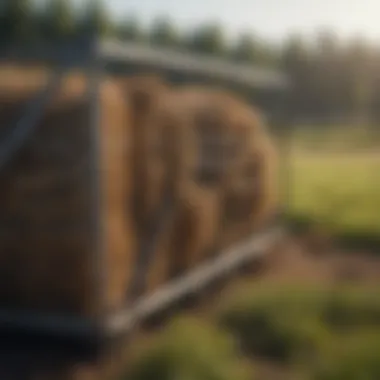

Traditional Hay Racks
Traditional hay racks are often made from wood and have stood the test of time in agricultural settings. These racks are typically constructed with slatted designs, allowing air to circulate around the hay, thereby minimizing moisture buildup. This ventilation is essential as it helps prevent mold and rot, maintaining the quality of the hay for a longer period.
Moreover, traditional designs are known for their straightforward construction, making them relatively easy to assemble without requiring fancy tools. Farmers might find that these racks blend well with the rustic aesthetic of a farm, offering both functionality and charm.
Pros and Cons:
- Pros:
- Cons:
- Natural ventilation
- Aesthetic appeal
- Easy to repair or replace parts
- May be less durable than metal options
- Wood can deteriorate over time if not treated properly
The use of traditional hay racks resonates with those who value heritage farming methods while still being efficient in their practices.
Modern Hay Racks
Modern hay racks are designed with advancements in materials and technology. Often made from galvanized steel or reinforced plastic, these racks address some of the drawbacks associated with traditional models. They tend to be sturdier and more resistant to the elements, ensuring a longer lifespan and diminished need for maintenance.
Additionally, modern hay racks can have features such as adjustable heights and modular designs that allow farmers to customize them based on their specific needs. This flexibility is particularly beneficial for larger operations, where maximizing space and adaptability is paramount. Modern racks may also include mechanisms to minimize waste; for instance, some are designed to dispense hay gradually, reducing the chance of hay being trampled or spoiled.
Key Features:
- Durability against weather conditions
- Customizable and adjustable designs
- Reduction in hay waste through innovative designs
Investing in modern hay racks might initially seem costly, but the benefits they bring often outweigh the investment, particularly in terms of long-term efficiency and cost savings.
Portable Hay Racks
Portable hay racks serve a unique role in the world of agriculture, especially for those who engage in rotational grazing. Made from lightweight materials, they are designed to be moved easily from one location to another. This flexibility allows farmers to place them where the need for feeding is most urgent or convenient.
These racks can vary in design, from simple frames to more complex structures. Some farmers opt for portable racks that can be disassembled for easy storage during the off-season. In addition to facilitating easy movement, portable racks help in managing grassland better by preventing overgrazing, allowing plants to recover more effectively.
Advantages of Portable Hay Racks:
- Flexibility to adapt to changing grazing patterns
- Helps in pasture management
- Easy to transport and store
Incorporating portable hay racks into feeding practices is particularly advantageous for farmers looking to enhance the sustainability and productivity of their operations.
Incorporating various types of hay racks ensures not just optimal storage of hay, but also enhances the well-being of livestock by promoting better feeding practices.
Construction Materials
In the realm of hay racks, the choice of construction materials plays a pivotal role. Each material brings its unique characteristics to the table, influencing the longevity, functionality, and overall efficacy of the hay rack. Farmers who understand these nuances can make informed decisions that enhance their agricultural practices.
Wooden Hay Racks
Wooden hay racks have been a staple in farming for centuries. Their traditional charm comes from the natural aesthetic of timber which blends seamlessly into rustic farm landscapes. Durability is often highlighted, particularly when using high-quality hardwoods like oak or cedar that resist decay better than softer woods.
The natural insulating properties of wood can also be beneficial during extreme weather, reducing heat loss in winter. However, it's important to remember that wooden racks require regular maintenance. Periodic treatments with anti-rot solutions can prolong their life, while physical checks for insect damage should not be overlooked.
Advantages of wooden hay racks include:
- Sustainability: They can be sourced from renewable forests.
- Versatility: Wood is easy to work with and can be crafted into various designs.
- Aesthetic Appeal: They often enhance the farm’s visual appeal.
However, their downsides include susceptibility to decay and pests, which can hamper their performance if not monitored.
Metal Hay Racks
Metal hay racks offer industrial strength and structural integrity unmatched by other materials. Commonly constructed from steel or galvanized metal, these racks are resistant to weathering and decay, ultimately requiring less maintenance. Their durability makes them suitable for larger operations where the longevity of equipment is paramount.
Additionally, metal racks often allow for better airflow around the hay. This design improves the drying process and minimizes mold growth, a significant advantage where hay storage and quality are indispensable.
Considerations with metal hay racks include:
- Corrosion Resistance: Look for options that are coated or treated to resist rusting.
- Weight: They might be heavier than wooden racks, which can affect mobility if portability is desired.
- Safety Issues: Sharp edges might pose a risk, necessitating careful installation and checks.
While they may lack the natural charm associated with wood, their utilitarian benefits often outweigh aesthetic considerations, especially in professional settings.
Plastic Hay Racks
Plastic hay racks represent a modern evolution in agricultural equipment. Typically made from high-density polyethylene or other durable plastics, these racks are lightweight yet strong, often designed for portability. Living up to their name, they are impervious to rot and decay, which makes them ideal for environments with fluctuations in humidity and temperature.
Another boon is the ease of cleaning. Unlike metal and wood, plastic can be wiped down effortlessly, aiding in hygiene maintenance for livestock's health. Additionally, they are available in various colors, making it easy to coordinate with farm aesthetics or branding.
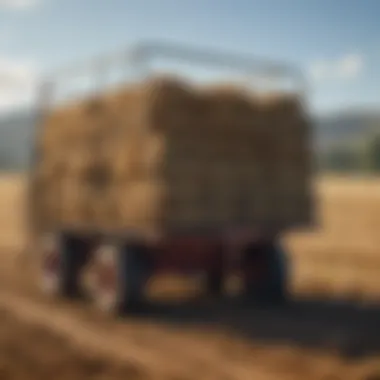

Some key points regarding plastic hay racks include:
- Recyclability: Many plastics can be recycled, aligning with sustainable practices.
- Cost-effectiveness: Often, they are more affordable than other materials, making them accessible for smaller farms.
- UV Resistance: Quality plastic racks are designed to withstand UV exposure without degrading.
On the flip side, plastic may be less durable under extreme conditions and can become brittle over time. Furthermore, their designs may lack the robustness required for heavy usage compared to metal.
The choice of material for hay racks is crucial. It impacts not just the immediate utility but also the long-term sustainability of the farming operations.
Through navigating these considerations, farmers and agronomists can select hay racks tailored to their specific needs and conditions. Knowing the pros and cons of wood, metal, and plastic helps ensure that the investment supports both efficiency in hay storage and the health of livestock.
The Benefits of Using Hay Racks
Using hay racks in agricultural practices comes with a slew of advantages that make them an invaluable asset for farmers. Not only do they provide functional solutions for hay storage, but they also enhance overall efficiency in feeding livestock, ultimately contributing to better resource management. Understanding these benefits can aid in maximizing the effectiveness of hay racks while underscoring their relevance in modern farming.
Space Efficiency
One of the foremost benefits of hay racks is their ability to save space. In a world where land is often at a premium, optimizing every inch becomes crucial. Hay racks, particularly vertical designs, utilize vertical space effectively, allowing farmers to store a larger volume of hay without consuming significant ground area. This creative utilization of space is a game changer, especially on smaller farms or in areas with strict zoning regulations.
- Compact Design: Many modern hay racks are crafted with sleek and sturdy designs that can fit snugly against a barn wall or in tight corners, freeing up room for additional storage or facilities.
- Organization: By elevating hay off the ground, racks facilitate easier access and organization, making inventory management simpler. This leads to less time spent rummaging through piles of hay, which is something no farmer looks forward to.
Reduced Waste
The second substantial benefit revolves around waste reduction. Traditionally, storing hay on the ground might expose it to moisture, mold, and even pests, leading to spoilage and waste. With hay racks, the scenario shifts. Elevating hay helps in minimizing waste and maximizing the utility of every bale.
- Protection from Elements: Hay racks help ensure that hay remains dry and clean, reducing spoilage caused by contact with soil or water. With less waste, farmers can enjoy more efficient feeding practices, ensuring that livestock receive quality nutrition.
- Pest Control: Keeping hay off the ground deters rodents and insects, which often see hay stored directly on the floor as an open invitation. By mitigating pest problems, hay racks contribute to maintaining the quality of the fodder.
Improved Airflow
Improved airflow is another significant advantage offered by hay racks. Proper air circulation around stored hay is essential for maintaining freshness and quality. Hay racks inherently allow for better ventilation compared to traditional storage methods.
- Drying and Curing: Good airflow assists in the drying process of freshly cut hay, ensuring it cures properly for future use. This can be particularly vital during harvest season when moisture levels fluctuate.
- Quality Preservation: Improved airflow prevents the buildup of heat and moisture, which can create an ideal environment for mold growth. Keeping hay fresh not only improves the quality of feed but also promotes livestock health.
Using hay racks significantly reduces waste, enhances space utilization, and improves airflow, making them a wise investment for any farm operation.
Hay Racks and Livestock Management
Understanding the connection between hay racks and livestock management is crucial for the effective handling of feed in any agricultural setting. Hay racks, by design, cater to the feeding needs of various kinds of livestock. They provide a structured way to present hay to animals, minimizing waste while maximizing accessibility. This section engages deeply with the role of hay racks in supporting livestock and outlines how these structures enhance feeding practices.
Support for Various Livestock
Different species of livestock have unique feeding habits, and hay racks offer tailor-made solutions to meet these specific needs. For instance, horses are often more selective eaters compared to cows, which can consume larger amounts of hay more ravenously. By providing hay in a rack, farmers can regulate the portions more effectively.
In practical applications, a standing hay rack is ideal for goats, allowing them to easily pull hay down while minimizing contact with the ground—keeping the feed cleaner and preventing spoilage. Often, large round bale feeders are used for cattle, accommodating their size and feeding behavior, which allows easier access for those larger animals.
"A specialized hay rack can both promote health among livestock and enhance feed efficiency, benefiting farmers in the long run."
Hay Racks in Feeding Practices
Integrating hay racks into feeding practices involves several considerations that ultimately enhance the livestock's dietary well-being. The design of a hay rack affects not only how feed is accessed but how much waste occurs in the process. Effective feeding involves strategic placement where animals can graze comfortably while preventing access to ground contaminants.
- Strategic Positioning: Position the hay rack in areas frequented by livestock, taking care to ensure it's away from wet or muddy spots. This helps maintain the quality of hay and ensures that animals remain healthy.
- Compatibility with Feeding Schedules: Modern hay racks can be adapted for rotational grazing systems. When livestock is rotated amongst different fields, aligning rack locations with grazing patterns minimizes feed waste.
- Maintenance of Quality: Using hay racks reduces contamination from droppings or bedding materials. As hay is lifted off the ground, it remains fresher longer, offering nutritional value and reducing the risks of health issues related to poor feed quality.
- Cost Efficiency: By limiting feed waste—often occurring when hay is simply thrown on the ground or stored improperly—farmers can save considerable amounts on hay bills over time.
In summary, hay racks play a fundamental role in livestock management, addressing the specific needs of different species while improving feeding efficiency and animal health. By implementing these structures effectively, farmers can ensure their livestock are well-fed, reducing waste and contributing to the overall sustainability of agricultural practices.
Implementing Hay Racks in Sustainable Farming
Hay racks play a pivotal role in sustainable farming practices, providing a practical solution not only for efficient feeding but also for enhancing overall environmental stewardship. The core idea behind sustainable agriculture revolves around methods that maintain productivity while conserving resources and minimizing negative impacts on the environment. So, when we consider hay racks, we acknowledge their dual functionality: they optimize the use of resources and address specific agricultural challenges.
Contribution to Sustainability
The benefits of hay racks are multi-dimensional. First and foremost, they help reduce the amount of waste produced during feed consumption. When hay is simply placed on the ground, it's not uncommon for animals to trample it, mix it with dirt, or leave it uneaten. However, hay racks elevate feed and keep it clean, ensuring that livestock consume more of what they need while leaving minimal behind. This directly translates into lower feed costs and less reliance on additional hay production, thus preserving vital land resources.
Moreover, hay racks promote better airflow around the stored feed, which can help inhibit mold growth. Mold not only diminishes the nutritional value of the hay but can also pose health risks to livestock. By avoiding these concerns, farmers enhance the health of their animals while fostering a more resilient agricultural system.
"Sustainable farming is not just about rates and numbers; it's about understanding the relationship between the resource and its usage."
Additionally, implementing hay racks can significantly contribute to soil health. When hay waste is minimized, there's a lower chance of nutrient runoff or soil degradation associated with leftover feed. By creating a cleaner feeding environment, these structures help ensure that soils retain nutrients more effectively, promoting a sustainable cycle of growth for future crops.
Recommendations for Sustainable Usage
To reap maximum benefits from hay racks within the framework of sustainable farming, farmers should consider several critical recommendations:
- Choose the Right Material: Opt for hay racks made from sustainable materials. Wooden racks, ideally sourced from responsibly managed forests, or recycled metal constructions are preferable. This choice complements the sustainability ethos.
- Size Appropriately: Ensure the size of the hay rack suits the number of livestock it will serve. Overcrowding not only affects animals' health but leads to more waste.
- Rotate Use: If possible, move hay racks periodically to different locations. This enables the land to recuperate and promotes better pasture management. It also reduces soil compaction in one area.
- Adjust Based on Season: During harsher winter months, consider using racks with additional protection against the weather. Structures that shelter hay can keep it dry, further preserving quality.
- Regular Maintenance: Keep the racks clean and well-maintained. Repairing any damage ensures longevity and performance, which translates to sustainable practices over time.
By putting these recommendations into practice, farmers can create a more efficient, sustainable feeding system that ultimately leads to healthier livestock and a more robust farm model. Hay racks are not just tools; they are part of a broader commitment to sustainable agriculture, reflecting a farmer’s dedication to both productivity and environmental responsibility.
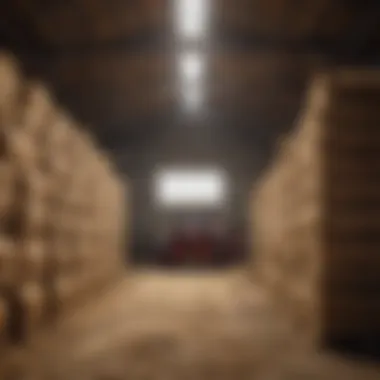

Challenges Associated with Hay Racks
As practical as hay racks can be, they come with their own set of challenges that farmers must navigate. These obstacles can hinder not just the effectiveness of hay storage but also the overall efficiency of agricultural practices. Understanding these challenges is essential for making informed decisions when choosing or maintaining hay racks.
Material Degradation
One of the main issues tied to hay racks is material degradation. Depending on what they're made of, hay racks can wear down over time due to exposure to the elements, especially if they are placed outdoors. For instance, wooden racks may rot or splinter if not treated or maintained correctly. This not only shortens their lifespan but can also affect the safety of the hay stored within.
It's crucial to regularly inspect the materials to catch any signs of wear and tear early on. Metal racks, while more durable, are not immune to rust, especially in humid conditions. Employing preventative measures such as coatings or coverings can help mitigate these issues.
"Regular maintenance of hay racks is a non-negotiable step in prolonging their functionality."
Moreover, the choice of material is often dictated by budget and availability. For farmers in rural areas, access to high-quality materials or repair services can be limited, adding another layer of complication.
Space Limitations
Space is always at a premium in agriculture, and hay racks are no exception to this fact. Space limitations can significantly impact the decision about where and how to utilize hay racks effectively. A farm with a smaller footprint may struggle to accommodate larger, more traditional hay racks, leading to poor hay management and inefficient use of available space.
Farmers often have to get creative—this can involve stacking or optimizing the layout of the racks. However, when space is tight, haphazardly organized hay can lead to wastage or spoilage, undermining the very purpose of using a hay rack. Additionally, overcrowded setups can make it challenging to access hay, leading to labor inefficiencies during feeding times.
Some may resort to portable options, but these come with their own logistical issues, such as transportation and setup time. Understanding how to best utilize available space, then, becomes fundamental to ensuring that hay racks fulfill their intended purpose while contributing positively to farm management.
Maintenance and Care of Hay Racks
Proper maintenance and care of hay racks is crucial for ensuring their longevity and efficiency in agricultural practices. Like any other equipment on a farm, hay racks require regular attention to keep them in good shape. This not only extends the lifespan of the racks but also enhances their functionality in storing and managing hay effectively. Neglecting maintenance can lead to structural failures, increased waste of hay, and ultimately, a loss in productivity.
Cleaning Procedures
Keeping hay racks clean is an essential part of their maintenance. Over time, debris, dust, and any residual hay can accumulate, leading to mold and pests. Here are some steps to ensure your hay racks remain clean:
- Routine Cleaning: It’s best to clean the racks regularly, ideally after each hay feeding session. Use a broom or a brush to sweep off any leftover hay and dirt.
- Deep Cleaning: Every few months, perform a deeper clean. This might involve washing the racks with water and a mild detergent. Be cautious with chemicals that could leave residues harmful to livestock.
- Inspection for Damage: While cleaning, examine for any signs of damage. If you find broken slats or loose connections, prioritize repairing these immediately.
Pristine racks not only prevent product degradation but also promote a healthy feeding environment for livestock.
Regular Inspections
Regular inspections of hay racks are just as important as cleaning. These inspections help to catch small issues before they become bigger problems. Here’s how to carry out effective inspections:
- Visual Check: Look for any signs of wear and tear, such as rust on metal racks or rot on wooden ones. If something doesn’t look right, it probably isn’t.
- Structural Integrity: Ensure that the racks are structurally sound and stable. Test the stability by applying light pressure. If the rack wobbles or feels unstable, it’s time for repairs.
- Schedule Inspections: Set a schedule for inspections, perhaps at changing seasons when conditions can affect the racks differently. This could help anticipate issues caused by weather changes.
Doing these simple checks can save you from larger headaches in the future and keeps your hay storage on point.
"An ounce of prevention is worth a pound of cure."
Keeping hay racks well-maintained minimizes your long-term costs and maximizes efficiency in the operation.
With proper maintenance and care, hay racks can continue to serve their purpose, making hay storage and livestock management more efficient and effective.
Future Trends in Hay Rack Design
In today's fast-evolving agricultural landscape, the design of hay racks is not just about practicality anymore. It has become a focal point in enhancing efficiency and sustainability. Farmers and agricultural enthusiasts alike are seeking innovative solutions that bridge traditional methods with modern advancements. These trends not only reflect a response to current challenges but also pave the way for future farming efficiencies.
Innovative Materials
As the saying goes, "you get what you pay for," and the choice of materials plays a pivotal role in the effectiveness and longevity of hay racks. Innovations in materials science are bringing forth options that can withstand the rigors of outdoor use while also being lightweight and easy to handle.
- Composite Materials: These materials are gaining traction. Made from a combination of different substances, they offer superior strength and resistance to weathering compared to traditional wood or metal. This means less maintenance and longer life spans for hay racks.
- Recycled Plastics: In a quest for sustainability, recycled plastics are emerging as an option. They are not only eco-friendly but also resistant to rot and pests, which can be a considerable advantage for farmers facing challenges from the elements.
- Metal Alloys: Specific types of metal alloys are being used to create hay racks that are lighter yet sturdier. These racks can easily be maneuvered across fields without compromising on strength.
The shift toward these innovative materials reflects a broader move within agriculture to prioritize sustainability without sacrificing functionality. The right materials can produce hay racks that not only hold up under stress but also contribute positively to the environment.
Technological Integration
Technology is similar to a grain of wheat—it can grow into something substantial if nurtured correctly. The integration of technology into hay rack design is opening up various possibilities for enhanced functionality and user experience. Farmers are beginning to see the fruits of this integration.
- Smart Monitoring Systems: Some modern hay racks are now equipped with IoT devices that monitor moisture levels and hay quality. This allows farmers to better understand storage conditions and make adjustments when necessary. If the moisture is too high, it can lead to spoilage. Smart systems can send alerts directly to the farmer's phone, enabling timely intervention.
- RFID Tagging: RFID technology is finding its way into hay management. By tagging bales as they are placed in racks, farmers can keep accurate logs of what’s in storage, simplifying inventory management and ensuring that older hay is used first, minimizing waste.
- Mobile Applications: Complementing smart racks, mobile apps are being developed to help farmers track and manage their hay inventory. With just a glance at their smartphones, they can access data on how much hay they have, its age, and even suggestions on when to feed certain bales to livestock.
The infusion of technology into hay rack design represents a notable shift towards feature-rich, efficient solutions that meet the intricate needs of modern farming. By embracing these advancements, farmers can leverage data-driven decisions for optimal hay storage and distribution.
"Innovation distinguishes between a leader and a follower."
– Steve Jobs
Ending
The exploration of hay racks in agricultural practices reveals several key aspects that are instrumental in understanding their role in modern farming. First and foremost, hay racks play a crucial role in optimizing the storage and usage of hay, which is vital for livestock nutrition. By providing a structure that elevates hay off the ground, these racks not only help in preserving the quality of the forage but also in reducing wastage due to spoilage or trampling. Moreover, this elevation promotes better airflow, which further aids in maintaining hay quality over time.
Recap of Key Points
- Hay racks reduce waste by ensuring that hay remains dry and accessible to livestock.
- Utilization in various livestock management strategies allows for better feeding practices, enhancing overall animal health.
- Sustainability efforts can be bolstered through the implementation of hay racks, which make more efficient use of resources.
- Material choices, such as wood, metal, or plastic, influence not only durability but also maintenance requirements.
- Advancements in design and technology promise to enhance the effectiveness of hay racks in future agricultural practices.
The Broader Impact on Agriculture
The implications of using hay racks extend beyond a single farm. Their efficient design contributes to more sustainable agricultural practices, as they minimize waste and maximize feed efficiency. This is particularly critical in a world where food security is constantly challenged by evolving climatic and economic conditions.
In addition, the shift towards integrating innovative materials and technology in hay rack construction signifies a trend that aligns with modern farming practices which prioritize efficiency and sustainability. It emphasizes the importance of adapting traditional practices to modern demands.
Ultimately, understanding the full scope of hay racks enables farmers and agricultural enthusiasts to make informed decisions, not only about their own practices but also contributing to the wider agricultural narrative. To sum up, hay racks are more than just a tool; they are a central component of sustainable and effective livestock management.





